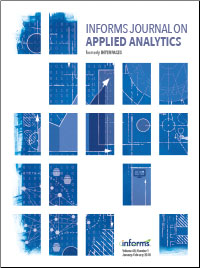Decision analysis (DA) is one of the key tools in operations research (OR). DA is particularly effective at mapping the real world to the model representation to enable the application of formal analysis. DA is a flexible modeling paradigm that has existed since the 1960 s, based on statistical decision theory, elements of utility from economics, probability theory, dynamic programming, and stochastic programming. It aims to identify an optimal course of action for decision problems with uncertainties that affect outcomes and values. Optimal here means expected-utility maximizing, which decision theory shows to be equivalent to following axioms of rationality given a set of beliefs.
DA articles have appeared with some regularity in Interfaces (the predecessor to INFORMS Journal on Applied Analytics (IJAA)), with early applications focusing on policy and later ones on research and development in consumer products, pharmaceuticals, and oil and gas, quite naturally because these applications have distinct decision points when investments are continued or cut off (which is the meaning of the Latin root decidere). A 1992 special issue of Interfaces, “Decision and Risk Analysis,” highlighted applications that used rich representations of decision problems, such as influence diagrams as an abstraction of the decision tree, strategy tables to define complex alternatives, and practical techniques involving value-focused thinking and value hierarchies to implement multiattribute utility theory.
All these developments help capture the knowledge and concerns of problem owners through model specification and judgment elicitation. In addition, DA models often interface with or subsume separate sophisticated technical or financial models. And DA representations aid in communicating the implications of models via, for example, tornado charts, portfolio diagrams, cumulative distributions, and risk profiles.
In recent years, DA has added sophisticated computational abilities. Although to this day many DA applications ultimately reduce to decision tree calculations or the equivalent, software has improved to include modular graphical development that interfaces with spreadsheets and programming environments such as R and Python. Theory connected to DA also continues to advance, for example, group decision theory and extensions of utility theory to multiparty situations in which considerations such as equity are important. There is a substantial amount of adjacent computerintensive work on Bayes nets, machine learning, and inference. The science of elicitation has grown exponentially, ranging from increased understanding of judgmental biases, wisdom of crowds, and other ways to combine judgments of multiple experts to increased mathematical and computational sophistication, most recently advancing with copulas to represent correlations of different natures between variables. As seen in this issue, DA is increasingly well linked with other OR techniques, such as math programming for portfolio DA, leading to innovations in scholarship and practice. Thus, DA is an exciting field of interest to IJAA readers on its own merits but also as a field that can add value to other areas of OR.
Saurabh Bansal, Jeffrey M. Keisler, Johannes U. Siebert, Karen E. Jenni (2023) Applying Decision Analysis to Diverse Domains: An Introduction to the Special Issue. INFORMS Journal on Applied Analytics 53(3):173-177. https://doi.org/10.1287/inte.2023.1163

Leave a Reply